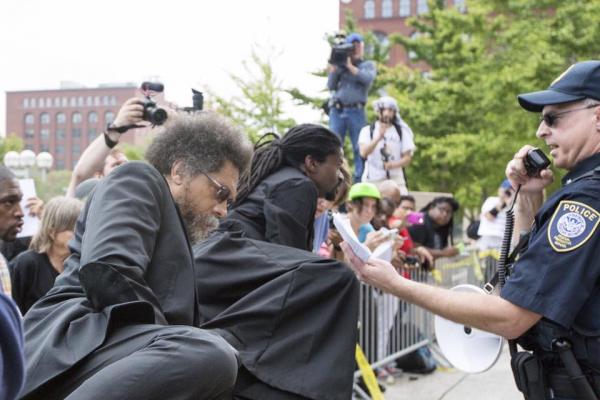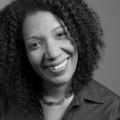One year ago, our nation got a wake-up call.
The death of Michael Brown on Aug. 9, 2014 was the third in a string of five police killings of unarmed black men that occurred over less than one month, including: Eric Garner (Staten Island, NYC, July 17), John Crawford (Beavercreek, Ohio, Aug. 5), Ezell Ford (Los Angeles, Aug. 11), Dante Parker (Victorville, Calif., Aug, 12). The quick succession of these videotaped police-involved deaths — and the Ferguson Police Department’s militarized response to protestors — ignited the longest civil disobedience movement in American history. The Ferguson protests have been sustained for 368 days now.
Some thought the protests would die out after the Darren Wilson indictment decision was announced. But the movement didn’t end — because the killing didn’t end.
The latest killing happened two days before the one-year anniversary of Michael Brown’s death when Christian Taylor, 19, crashed his SUV through the window of a car dealership in Arlington, Texas. Officers shot him in the course of a struggle. In fact, as I write this, there have been 601 lethal police shootings in 2015, 24 of them unarmed black men, according to an ongoing independent analysis by The Washington Post: That’s an average of three unarmed black men shot dead by cops per month since January. This number does not include police shootings of black women, police killings that did not involve gunfire, or deaths while in police custody. Freddie Gray’s and Sandra Bland’s deaths are not included in The Washington Post's tally.
Over the course of the year since Michael Brown died, we have learned critical lessons that have fueled the movement, bringing together young activists, clergy, and evangelicals in unlikely, yet cohesive alliance.
Young people take action
Immediately after Michael Brown’s death, young people took to the streets, compelled by the raw injustice surrounding his death and provoked by the militarized response of the Ferguson police. Groups of young people found each other and formed loosely knit coalitions like Hands Up United, Organization for Black Struggle, Tribe X, Millennial Activists United, and others.
Johnetta “Netta” Elzie shared during a recent interview with me on the streets of St. Louis: “Michael Brown’s death resurrected me.”
After high school Netta ran from leadership, fed up with trying to prove her worth by being perfect in a mostly white world. She rebelled but had no cause.
“In August of last year,” Netta said, “I learned that it’s okay to be defiant if you believe in the cause. And I believe in black people.”
Netta’s family stopped talking to her. They took her car to stop her from going to the protests. It didn’t stop her. Netta’s was one of the primary voices that rose from the chants, the marches, and the social media blitz that propelled the movement forward. Netta and DeRay McKesson started This is the Movement, a daily newsletter update of actions and preparations for Ferguson protests and other protests around the nation.
Alexis Templeton, co-founder of Millennial Activists United, shared at The Summit in June how she had considered taking her own life the day before Michael Brown died. Hopelessness had overcome her, yet somehow she felt drawn to the site where his body lay baking in the oppressive August St. Louis sun. She felt compelled to engage and began to march every night. It was there that Alexis found her calling. She joined forces with Brittany Ferrell to create Millennial Activists United and the two eventually joined forces in marriage.
Alisha Sonnier, one of the organic leaders of Tribe X, told me the Ferguson movement clarified for her: “the people who talk vs. the people who love.” It also taught her that Ferguson is everywhere. She told stories of people from Palestine tweeting to Ferguson organizers during the uprising last year: “This is how you deal with the tear gas. This is how you deal with the pepper spray … ” Then they visited and helped the young people understand the historic contexts of militarization and colonization.
“You realize it’s not only about Ferguson.” Sonnier said.
“It’s really about this interconnected, international, global, systematic oppression.”
Local clergy provide touchpoint for organizing
Rev. Starsky Wilson, pastor of St. John’s United Church of Christ and CEO of the Deaconess Foundation, rewrote his sermon the Sunday after Brown’s death. In it he raised the question: “What if this was our Christ?” Wilson called St. John’s church to take its portion of the responsibility for the blood of Michael Brown, confessing that Brown’s death was allowed to happen because the church had not engaged the lives of black men seriously.
Rev. Wilson said that in the initial phase of the movement, one of the key lessons was the deep divide between the young people on the streets and the clergy.
Over the past year, clergy like Rev. Wilson, Rev. Renita Marie Lamkin, Rev. Tommie Pierson (Pastor, Greater St. Mark’s Family Church), Rev. Traci Blackmon (Pastor, Christ the King UCC), Rev. Dr. Cassandra Gould (Pastor, Quinn Chapel AME Church in Jefferson City, Mo.), Rev. Osagyefo Sekou (Fellowship of Reconciliation), Rev. Mike Kinman (Christ Church Cathedral), Rev. F. Willis Johnson (Wellspring Church), and Rabbi Susan Talve (Central Reform Congregation) among others, have actively engaged with the young people, discovering that their fiery passion is matched every bit by disciplined study of the issues and sharp strategic discernment.
Gould explained to me, “The black community in St. Louis used to simply roll over and take it.” Ferguson was the first time she witnessed the community saying, “We’re not taking it anymore.” And it was largely the leadership of the young people that made the difference.
Evangelicals join the movement
And there is another group that used to be more comfortable in its staid silence: evangelicals. Faith for Justice leaders have Michelle Higgins, Howie Meloch, Craig Scandrett-Leatherman, and Amy Pederson have been attending multiple Ferguson coalition meetings and organizing a growing base of evangelical support for the movement for the protection of black lives.
Throughout the country, large swaths of evangelicals are coming to the table, eager to listen and learn from the movement. It’s a welcome development, and we encourage all people of faith to continue to read and learn about how #BlackLivesMatter has implications for our theology.
This past weekend all of these groups — young leaders, clergy, and evangelicals — came together under the banner #UnitedWeFight. They called the city to lament the death of Michael Brown, mine the lessons of the past year, vision for the next leg of the movement, and take action together. Multiple trainings took place, black scholars considered the higher lessons of the movement, coalitions hosted a block party for the community, clergy led a sunrise service around the makeshift Michael Brown memorial which stands on the spot where he died on Canfield Avenue, and other forums delved into Jesus and justice.
On Monday, everyone — nearly 300 young and old, black, white, Latino, and Asian people, people of multiple faiths and no faith — marched together from Christ Cathedral Episcopal Church in downtown St. Louis to the Department of Justice. The protestors stood on the steps of the Justice Center and read a set of demands, principal among them, that the DOJ not only issue a report about Ferguson, but that the department does its job by stopping unjust policing practices and dismantling the Ferguson police department.
The clergy asked to deliver the demands, which were written on a scroll, to the attorney general. They were denied. So, Dr. Cornel West, Rev. Osagyefo Sekou, Rev. Renita Lamkin, and others jumped the police barricades in a group of 57 protestors who attempted to enter the building to deliver the demands. They were all arrested. Police also arrested Netta and DeRay, even though they were only present to report on the protest.
The remaining protestors turned their backs to the police, who were preparing to arrest them. They sat down on the steps of the Justice Center and observed 4 ½ minutes of silence in remembrance of the 4 ½ hours Michael Brown’s dead body lay on the ground one year before. Then the group marched away.
“My military ID fell out of my pocket when the Federal Marshals were processing me,” Rev. Dr. Higgins, Dean of Students at Covenant Theological Seminary, told me.
“One of them picked it up. He was surprised to see that I am a full colonel in the Army. He said: ‘What are you doing here?’ I replied, ‘I think our country can do better.’”
Got something to say about what you're reading? We value your feedback!

